Firstly, before we get started, my family and I have not “arrived”. Nothing is perfect. I still struggle with the little things. These days, the kids can almost get all their winter gear on by themselves, so my old mantra, “I am the snowsuit” may be shifting to some new frustration that catches me in the act of not being in the moment. Confession: I have at times, cursed all mitts with thumbs made for small children, and all boots that have a separate thermal liner, destined to be squashed at the bottom of the outer boot, over and over again.
So now that I have laid bare the imperfections of my impatience, this article can hopefully land in a way that is really more about dreaming sacred spaces, schedules, and a slowly lived life into being…on a shoestring budget.
The first building project that my beloved Ian and I did was initially going to be a canvas tent made out of 2×2’s, as a getaway space to be pitched on his employer’s 16 acres, near Cooking Lake, Alberta. What really happened was that we used salvaged material already stored on that property and built a tiny house in the woods. It was 10×16 with two lofts that had 40 sq. feet of overhang on either side. One loft was our bedroom, and the other was our teenage daughter’s bedroom, who lived with us on weekends.
The home was wired, but had no plumbing, and we had to pilgrimage to a shop bathroom that was quite cold in the winters! We lived there rent-free for 2 1/2 years, and, except for a postpartum hiatus of housesitting for “snowbirds”, we even lived there with our newborn, my first baby.
With our growing family, we soon realized we needed more space, and so we looked for the only affordable property we could purchase in the whole county. Being two artists, it was a miracle that we could even walk into a bank and ask for some semblance of a mortgage.
So, we embarked on purchasing a 600 sq. foot cabin by a lake, in a bedroom community near the city. We were able to secure a “purchase-plus-improvements” mortgage on it, and began gutting it in the springtime, when our baby was about 6 months old. It was a massive “before and after” project.
After two years of living there, we talked about buying land in Manitoba, where my family lived. My sister sent me a listing of 80 acres of land near Riding Mountain National Park. It had a 1970’s mobile home, two metal granaries, one wooden granary, and a barn. That was what we could see from the Google Earth map, anyway. It also looked like it had ponds on it at one time.
We moved to Manitoba in the summer of 2017, and the first few nights in the mobile home were memorable. A thunderstorm hit, and we realized the windows leaked. Luckily, my husband is the Andy Goldsworthy of scrap material, and he whipped together a beautiful roof and an awning with metal he found in the yard.
We shoestring renovated inside the mobile home and got set up for living there for two years, while we turned the barn into our home.
Ian also made a studio for me out of the cube off a 1960’s delivery truck that was sitting in the barnyard. I have made my living as a musician out of that salvaged container, which is where I am sitting as I write this.
We find ways to build in a way that complies with regulations, but also matches our desire to use as much salvaged materials as possible. In other words, we choose not to live in a shack, and we choose to pass inspections with sewage, electrical, standards, etc., but we work equally hard at upcycling what others had thrown away.
Being on 80 acres prompted us to delve more deeply into permaculture and regenerative farming practices – which is really to say, we practice a form of agriculture that builds soil versus the more common farming practice of extracting and depleting soil.
Another name for this type of farming is known as the “beyond organic” movement. Once organic food became in demand, there were soon ways to grow organic food in a monoculture style that still causes soil loss in the millions of tons every year. Also, an almond tree, for example, can be certified organic, but can still be irrigated in ways that require extracting water from second and third non-renewable aquifers. So organic isn’t necessarily “green”.
Spiritually, a big “aha” moment for me was when I was reading The Independent Farmstead by Shawn and Beth Dougherty, while also reading Cynthia Bourgeault’s The Wisdom Jesus. I was moved by how a farm can be designed in a way that begins to overflow with surplus, and this idea of the “telltale sign of abundance” that we see in Jesus. Bourgeault tells us that some spiritual paths are about the conservation of energy, and are named as an effective path. But she also says it is not the path we see in Jesus – that he was radical in his overflow of energy, as though it came from an eternal source. The sacred geometry of nature behaves that way, too…cacophonous in its radical overflow of life. That is why I call Jesus a “radical earth dweller”.
Then, once I caught on to John Dominic Crossan’s work on Jesus’ move to Capernaum, as a possible act of food sovereignty (catching fish abundantly, in the face of the new corporate fishery at Tiberias on the Sea of Galilee), I became deeply motivated to find ways to peripherally support farm movements initiated and run by people of colour, and Indigenous people.
Then I read Charles Eisenstein’s book Sacred Economics, at around the same time that I read Robin Wall Kimmerer’s Braiding Sweetgrass…and I turned my online music store into a “gift economy” model, where people can come and receive all the music as a gift, or consider giving a gift in exchange. In that model no one is left out, and a beautiful network of giving and receiving takes place, like a constellation, that moves beyond “me”.
I could write for many more days, about all that we can dream, especially in the advent of the coronavirus, as we reel together in different ways. Admittedly, when I see memes about how things will someday be back to normal, I hear a line in my head from the philosopher Jiddu Krishnamurti: “It is no measure of health to be well-adjusted to a profoundly sick society.”
I wonder if we’re being asked to dream in gentle surrender during this strange global initiation.
At the outset of Covid-19, my friends who work hard running our local food bank and I dreamed up ways that we can create local resiliency.
The coronavirus has made more people than ever before stop to think about supply chains.
Just imagine how much perennial or annual food could be grown around the edge of one city. Imagine how much fertilizer for fruit trees one city makes each day, that otherwise gets flushed into our rivers and oceans as pollution? Plato’s philosophy, Christianized in the 4th century by Augustine, that spirit and matter are separate, (and that spirit is “above”, or chastity is higher), takes us to the disconnect we have today…that we are above our poop (and ourselves) going back to the soil.
One of the reasons why I see poetry in the choices we’ve made as a family (to learn how to make our homes, to grow our own food, to live within a sacred schedule) is that there is so much encounter and intimacy in them.
To encounter a couch on the back of someone’s truck, about to be tossed into the landfill, and bring it home to clean, and live with. To encounter the wood from old buildings or docks and turn them into the walls who will watch over you, as you live out your days. To dance with all the life that springtime has to offer a farm. Our milk cow Lady Susan will be calving. Our wonderful pig, Elizabeth Bennet, will be farrowing. Our children will be encountering the trees and other forms of life, as friends.
As I write this, I can see our dog, Lucy Pevensie, outside my studio window, chewing with ferocity and contentment on some antler bone she found in the woods. There is so much beauty to tasting, to the tactile, and to the practice of being in our bodies. As Richard Rohr says, “This is a “Christ-Soaked” universe.” And as Martin Buber wrote, “All real living is meeting”. Remembering the incarnational reality of this world can help us to keep meeting all that is around us, so that we might tease out an ancient/new story, made up of deeply connected constellations, that could be more intimate and authentic than before “distancing”.
May it be so.
For more about Alana, her music and other projects, visit www.alanalevandoski.com
You can also follow her on Facebook and Twitter.
Photos courtesy of Alana Levandoski


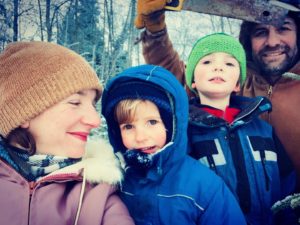
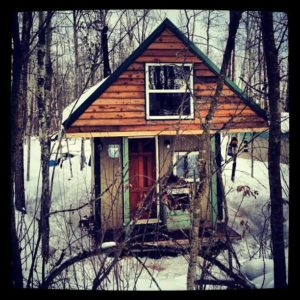
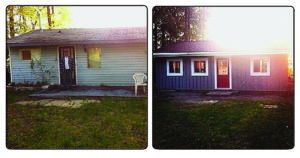
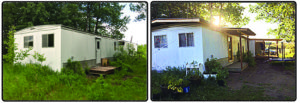
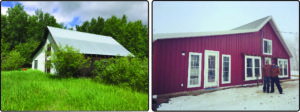
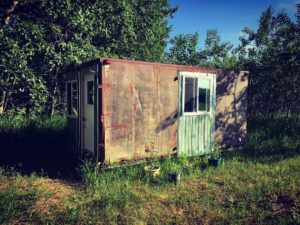
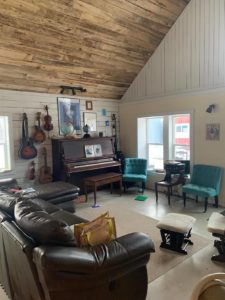
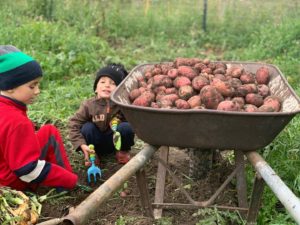
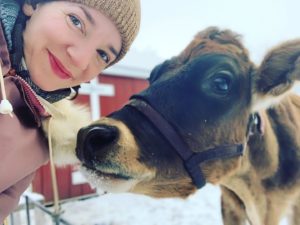






This is so inspiring, as I listen to Alana’s Behold I Make All Things New